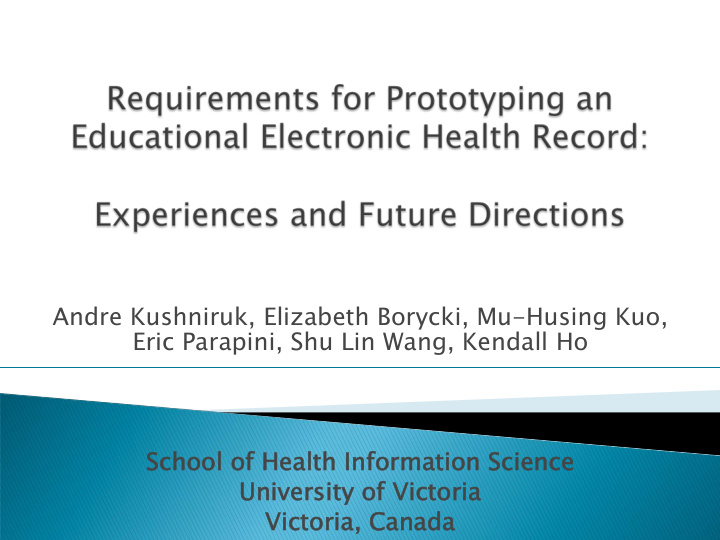



Andre Kushniruk, Elizabeth Borycki, Mu-Husing Kuo, Eric Parapini, Shu Lin Wang, Kendall Ho School of Health th Informati tion Science University ty of Victo toria Victo toria, Canada
How Can We Improve Adoption of Electronic Health Records (EHRs) Through Education? – Increase EHR adoption by: • exposing students and practitioners to hands-on access, through remote, widespread and easy access to systems • Enabling students, practitioners and managers to distinguish between systems and see how they can be used in their practice and educational settings • Increasing understanding of use of systems, decision- making knowledge – This is expected to result in: • Reduced financial and human resources burden on universities, colleges and regional health authorities for e- health application education and training
Our Solution – Phase 1 • Development of a portal that allows students and practitioners: – To remotely access and interact with real EHR software (from anywhere and anytime ) – To obtain the latest information about EHRs and actually try them out in their educational or clinical practice settings – in realistic contexts – To learn about the use of different EHRs in the context of problem-based (PBL) learning and also at their own pace
Users of the Portal • Health professional students – Medical, nursing, pharmacy, nutrition, physiotherapy, social work, health services and information science – Has included thousands of students throughout the province • Practicing professionals wanting continuing education about healthcare IT
◦ A portal EMR was converted to an educational EMR by two of our students, and made available on the portal over the WWW ◦ Used in pilot with all 4 th year medical students in December (over 240 students and faculty) – Island Medical Program, UBC main campus and UNBC ◦ Medical cases previously accessed on paper were now made accessible only using th the EM EMR to students during a problem-based (PBL) learning educational module Case of “ Tom ’ s Backpain ” which evolved over the weeks using the computer simulation (embedded in the EMR) ◦ Allowed medical students to experience EMR first hand during PBL
} Integrated simultaneous lecture discussion of EMR with hand-on experience and inserted experience into distributed medical education program in BC } Intent to include EMR as tool used in PBL (problem based learning) – students had to access EMR to get the “ case of the week ” (which was programmed to change over the week – e.g. as new simulated patient data is made available) } Intent to teach about the technology AND about medical practice/knowledge
} Nursing Education ◦ Extended to education of several hundred nursing students throughout the province ◦ Portal was introduced in Trends in Nursing course } Health Informatics Education ◦ Used by over 100 health informatics students in design and testing of a Web-accessible international EMR for pediatric cancer care - POND (in collaboration with St. Judes Research Hospital, Memphis) ◦ Can be accessed by students remotely ◦ Centerpiece of courses on electronic health records at Uvic ◦ Focus of these students was to learn how to modify and customize the system
} Objective: Determine requirements for an “ideal” health professional EHR learning environment } To be made available to all medical programs in Canada } Desired list of features both for instructors and for students } Methods: data obtained from interviews and focus groups with both faculty and students } Results - Desired Features: ◦ Authoring capability for instructors to easily enter patient cases to run simulations ◦ Ability for instructors to specify timeline for release of information to students over time (e.g. consult reports) to simulate real life
} “Training wheels” approach to features ◦ Only basic features in year 1, more advanced in year 4 of medical education } Ability to track user interactions ◦ To be used as input to “educational data mining” } Ability to build tutorials and quizzes into key points in use of the EHR } Ability of student to reflect on their use of the EHR and their issues and challenges in doing so } Ability to be modified for different student groups (e.g. each to teach medical and nursing students how to use, teach HI students to modify)
} In collaboration with Dr. Alex Kuo (UVic) } We are currently modifying an EHR that was developed as a class project in a database courses } The EHR is stable and implemented using ORACLE Apex } Desired features of Educational EHR are being programmed in, in particular simulation features } Plan to extend local server approach to cloud- based commercial hosting
Prototype Educational EHR . Instructor view: data entry for populating student cases for simulations
Prototype Educational EHR Instructor view: timeline for setting release of patient data to students
Prototype Educational EHR Student view: quiz delivered to student
} Allowing students remote access to real working systems (e.g. EHRs, PHRs) allows both students and professionals to explore this technology in a safe and user-friendly environment } Experience has been gained in doing this successfully in the past } Current work on how to develop optimal } Educational EHR features } Technical Platform for hosting } Integration within health informatics and health professional educational programs
Recommend
More recommend